This is one of my favorite old transmitter memories. Back when I landed my first Chief job, I was working for an AM/FM combo. The AM station was a 50,000-watt flame thrower that first went on the air in 1947. The original transmitter, a General Electric BT-25-A was still in service as a backup unit. These pictures are from the last night it operated, December 16, 1993. The bank made us remove all of the PCB transformers and capacitors before they would refinance their loan. Of course that was most of the transmitter, the rest of it was scraped or sold for parts.

The transmitter takes up the entire span of the room. There were eight large cabinets, each with its own stage or section. The stages were connected to each other by a wiring trough in the floor. The transmitter used lead-jacketed cable within and between sections.
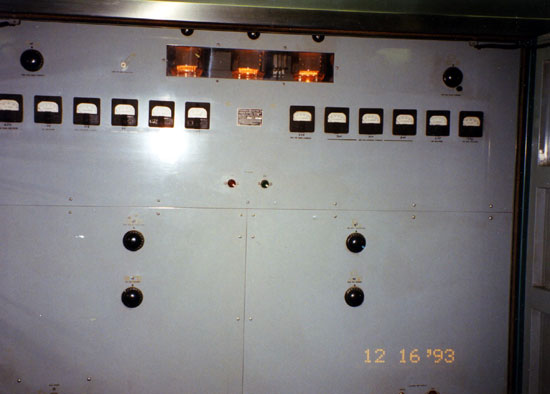
The IPA section had been modified to use 833A tubes. This is where the RF was developed and amplified for the final section. It is in the middle cabinets of the transmitter, the audio and control section being to the left, the PA and PA power supply being to the right.
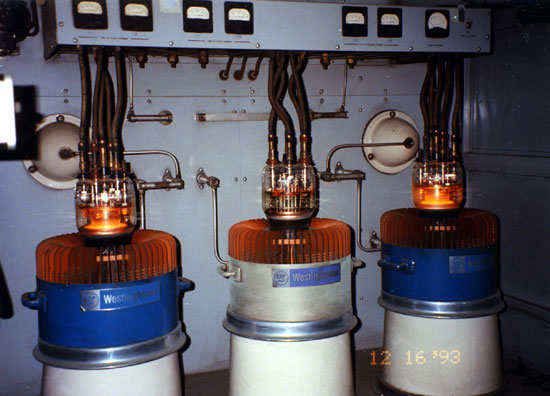
Final section. There were three tubes, only two were in use at any given time. The third tube was a spare which could be quickly placed in service by throwing a knife switch and moving those bars on the back wall around. This picture was taken with filament voltage only, we had to close the door to turn on the PA voltage.

The transmitter was cooled by this blower which faces down into the floor. Concrete duct work carried the air to the various stages of the transmitter. The blower is powered by a 2 1/2 HP motor. There were two blowers, one in use and one in standby. Behind this is an air mixing room and filter room. During the winter time, the transmitter waste heat was used to heat the building by closing a series of ducts and opening other ones.
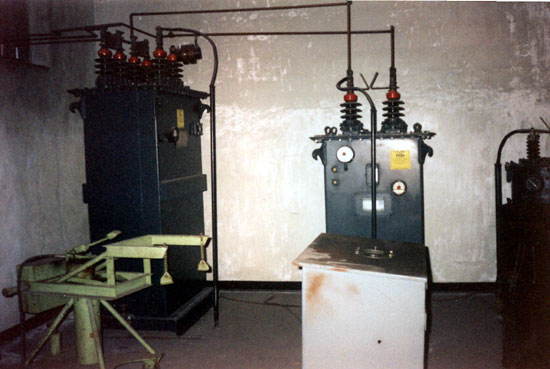
This is in the transformer vault. The unit to the left is a modulation transformer, it was 7 feet tall. Directly in front is the modulation reactor and just out of the picture to the right is the plate transformers. The plate supply was 480 volts 3 phase. The other piece of green equipment is a hydraulic tube jack, to get the 5891 final and PA tubes out of their sockets.
The transformers were what contained most of the PCBs. The modulation transformer contained about 150 gallons of Pyranol, the GE trade name for their transformer oil. Pyranol contained greater than 750,000 parts per million PCB.
It is a shame we had to kill this transmitter, it sounded wonderful on the air. The day we signed it off, there was nothing like it, not the Mw-50B that replaced it, nor the Nautel ND-50 that replaced the MW-50, nor the DX-50 at the competing station across town.
What a shame.


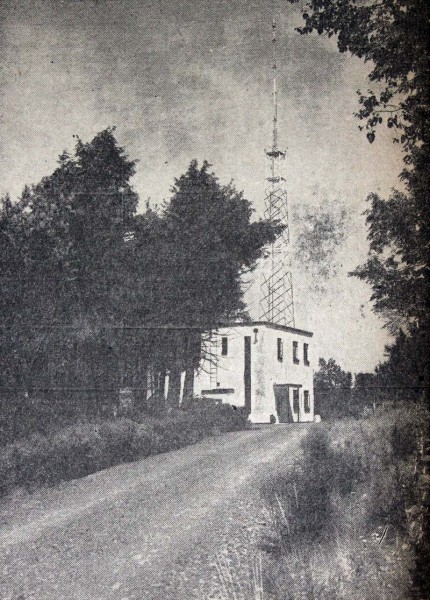

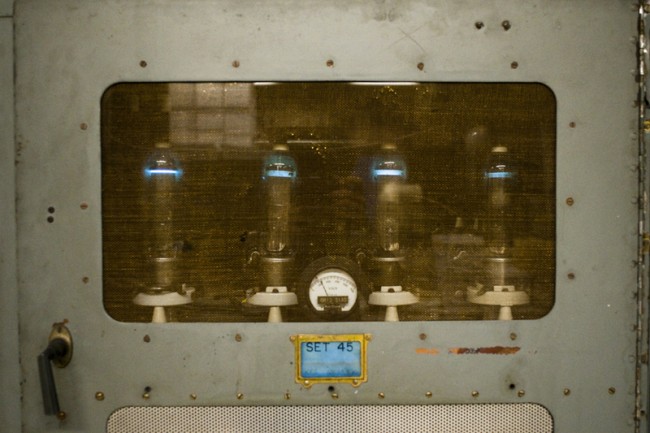

Where was this GE BT-25A??? I agree with you completely. The 50 kW transmitters with triodes modulating triodes are gone but never to be forgotten for their “SWEET SOUND”!
In thinking it over about this GE BT-25, I would have probably investigated draining the Pyranol and replacing with a modern high dielectric constant oil to satisfy the bank. This whole PCB thing, I believe has been blown way out of proportion. Poly-chlorinated-biphenyls do contaminate everything they come in contact with; however instead of the government treating everyone as dummies and banning an excellent dielectric, wouldn’t it have been better to issue awareness training for the proper care and feeding of this substance? There were thousands of pole pigs sitting high above city streets made by GE that used their trademarked “Pyranol”, and also Westinghouse with their trademarked “Interteen” that remain today. Why the broadcast industry was targeted, I don’t know. To me, there is nothing wrong with a good product that happens to be dangerous. It may only be “dangerous” or “hazardous” to people who do not know how to handle it! During the past few decades, big government has turned on the sirens and turned up the heat on everything that is remotely HAZARDOUS. Everything is hazardous, from turpentine to anti-freeze, and PCB to lead paint. Our water supplies that contain small traces of radium, and our basements that contain small amounts of radon gas are the horror stories and scares of the day. Wisconsin building codes will no longer permit soldering copper plumbing pipes with 50/50 lead solder. Antimony based solder must be used. Tetra-ethyl was removed from all gasolines in 1975 and replaced with oxygenates which resulted in lower octane ratings, poorer mileage, and valve damage to older engines. This all in the name of Progress and protecting one from himself. We still operate Nuclear Plants and they are pretty hazardous, but the Nuclear Regulatory Commission is there to make us feel safe, and issue announcements that “only a very low amount of ionizing radiation was released into the atmosphere” with absolutely no need to worry.
It looks like the white box with the slanted top directly in front of the modulation choke is the capacitor to isolate the DC current from the modulation transformer secondary, correct????
Actually, I think that is a bit of a left over ATU. The transformer vault became somewhat of a storage area, as evidenced by the hydraulic tube jack on the left side of the picture.
Was this rig at 1540 WPTR?
@Jim, indeed it was.
What did the PCB transformers have to do with having a loan refinanced? Why take a transmitter off the air over that?
The owner wanted to leverage his existing properties to buy more radio station, which required getting a new loan from the bank. The bank, always interested in not being screwed over, did some due diligence, sending a guy over to examine the loan collateral. Before he left, he said:
“What is with all these PCBs?
We don’t like PCBs.
We don’t like the potential liability associated with PCBs, especially as the transmitter site is located next to a wet land and most of the surrounding houses have water wells for there water source.
We don’t like all these PCB warning signs,
We don’t like the fact that if there is a fire back there, the building will be condemned due to dioxin contamination.
We are risk adverse and do not like exposure.
We are not telling you what to do, that is up to you. However, if you want us to look upon your loan application favorably, the PCBs have to go.
And so they went.
Well,I can now understand the bank’s position about the PCBs and the transmitter site being next to some wetland area and not wanting to be held liable if that would become contaminated,not to mention homeowners’ wells for water supply. Why couldn’t the station owner just switched the
transformer oil over to the other type? Would the bank had given him the loan on that condition alone,or not? That GE could have been kept on the air a few more years!
The environmental wackos and the trial lawyers have the money people scared stiff of litigation! This is one of the reasons America is slowly “going out of business”. When the trial lawyers started advertising, I knew there would be trouble! And these birds of a feather with the environmental extremists have contributed greatly to the demise of America. If the BT-25 was mine, the transformers would have been easily flushed, and a modern enviro-friendly dielectric would have replaced the GE Pyranol. The BT-25 would then still be usable as an alternate main or standby at a huge cost saving.
Paul,
I was ass’t CE at WPTR under Jim Cruise in the late 70s and was there for the install of the MW50. When I got there in 1977 the GE was still the main tx, and we had an old RCA 5DX in the transformer vault as an aux. The GE was the first 50kw rig I ever worked on — and also the first rig I could actually walk into. It sounds great on the air because of all that iron…actually better than the MW50 IMHO…with a much better bottom end.
Regarding the PCBs….
I can remember Jim and I opening up the HV transformers one night to replace the Pyranol and being up to my arm pits in the stuff. Not a difficult job, but now that I look back on it, it’s pretty scary. Of course, this was in the days before anyone ever heard of PCBs.
Regarding that box….
I believe that was part of the iso for the WPTR sign on tower one, although I could be wrong about that.
Rene’
What a shame- would pay to see these old rigs!
The old buildings designed for them and REAL radio !!
🙂
🙁